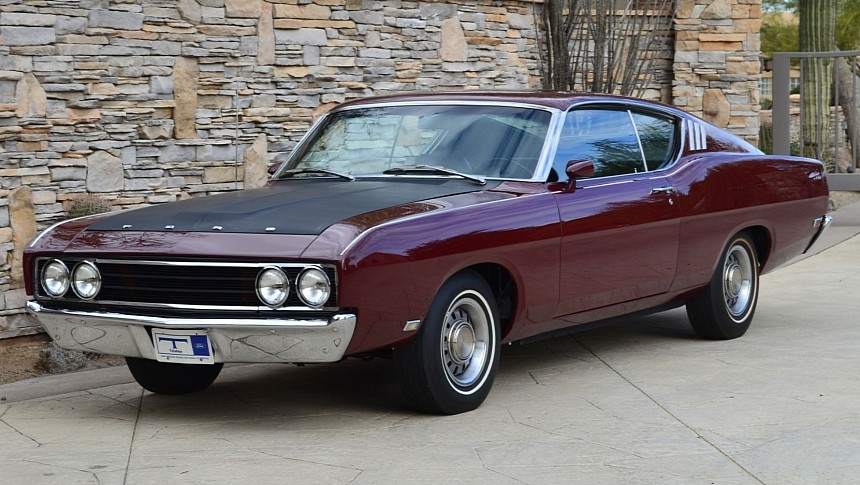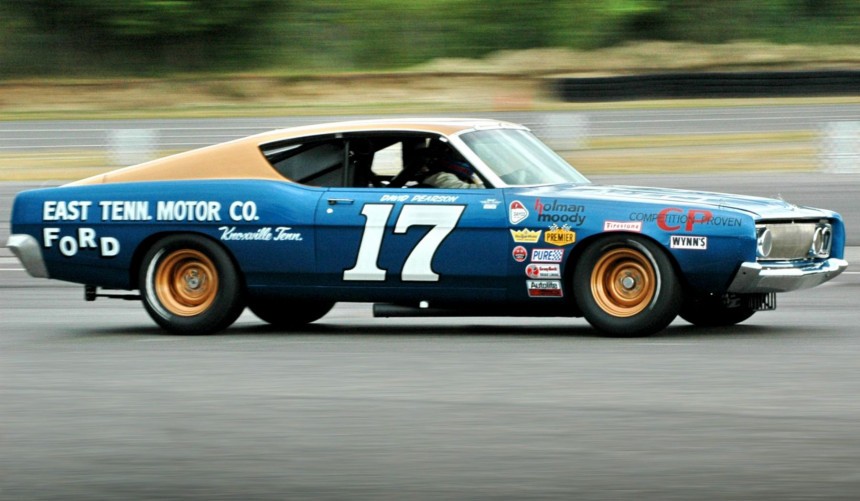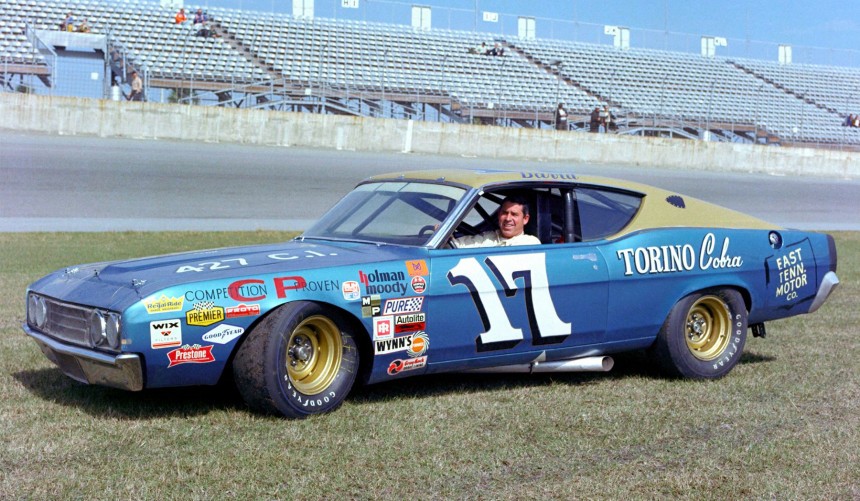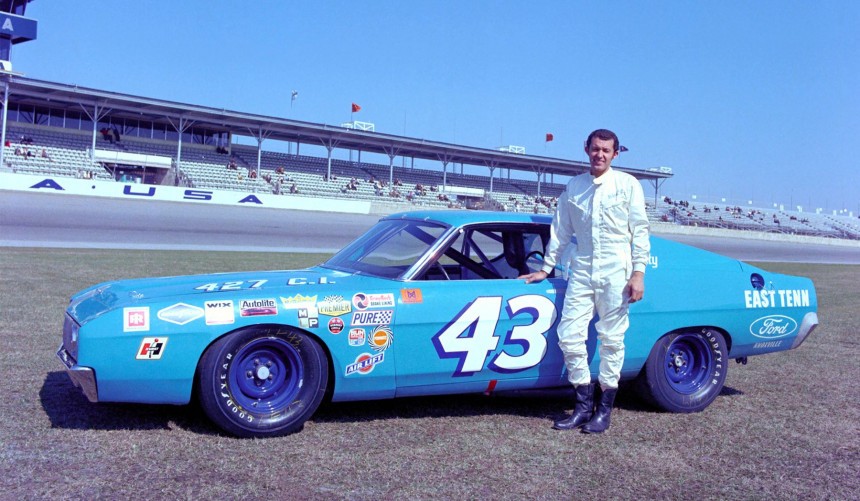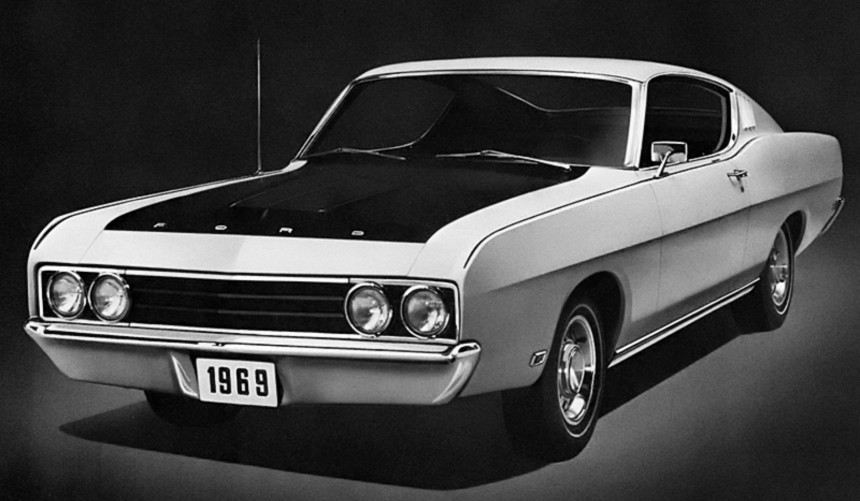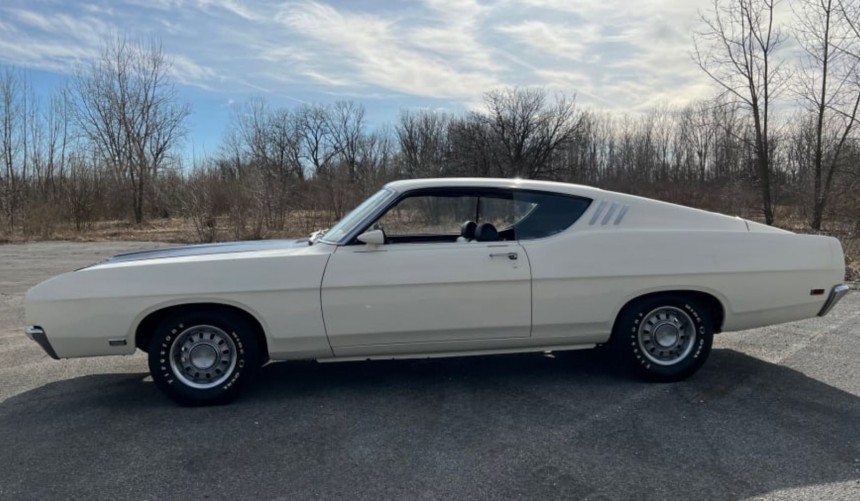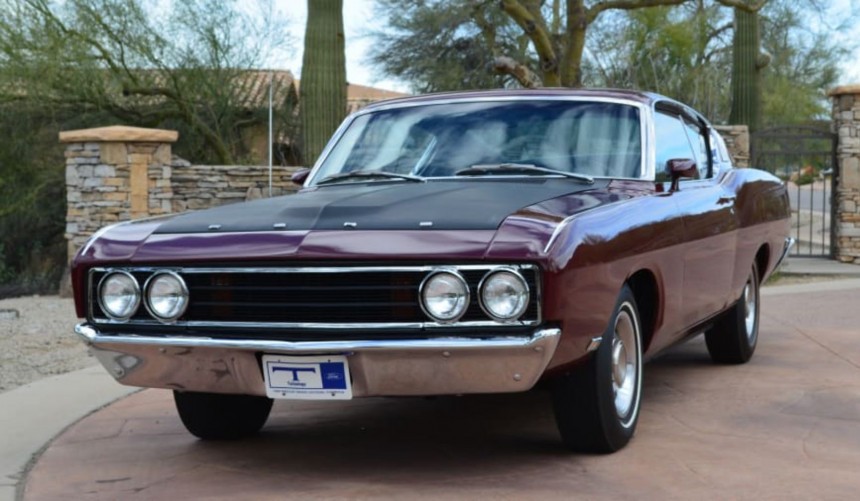Whether in race or street-legal homologation special guise, the 1969 Ford Torino Talladega was one of the first American-built performance cars developed with a keen focus on aerodynamics rather than raw power.
Back in the 1960s, long before highly-publicized Nürburgring runs or social media, the best way to sell a performance-oriented car was to take it to the track and cross the finish line first.
In the US, Detroit's Big Three were aware of this, so the corporations pumped vast amounts of money into their racing programs.
The biggest, most contested stage was NASCAR, where, unlike today, race cars closely related to their mass-produced counterparts were battling for supremacy.
During the first part of the decade, the battle was somewhat evenly contested, but after Chrysler introduced the game-changing 426 HEMI in 1964, its divisions became unbeatable. NASCAR was quick to outlaw the Elephant engine, and although this led Chrysler to pull out of the competition for the 1965 season, the corporation returned a year later, resuming its reign of dominance despite the ongoing restrictions.
David Pearson and his Dodge racked up 15 victories and the overall championship in 1966. The following season proved even more lopsided, with the Mopar contingent combining for 36 race wins in addition to Richard Petty's record-breaking title run behind the wheel of a HEMI-powered Plymouth Belvedere.
Meanwhile, the Ford camp was celebrating its second consecutive win at Le Mans, an achievement that no Mopar would replicate to this day. However, back home on the all-important NASCAR stage, the Blue Oval was getting its behind whooped, winning only a mere ten races that year.
The corporation's decision-makers were far from pleased with the lackluster performance on home soil, so in 1968, they commissioned a broad range of redesigned models meant to make its brands competitive.
These models included the Mercury Montego, Cyclone as well as the high-powered Ford Fairlane 500, and the Torino - a brand-new premium subseries of the Fairlane lineup.
Though it was available in a multitude of body styles, the coolest, most sought-after Torino became the two-door fastback (aka SportsRoof), which in GT trim was a thoroughbred muscle car available with a trio of high-powered V8s and a multitude of performance upgrades.
The fastback Torino equipped with the venerable 427 race engine, became Ford's new NASCAR challenger.
Despite being less potent than the HEMI Mopars, the fastback body proved more aerodynamically efficient, earning Ford 27 victories out of 49 races. Moreover, David Pearson and his no. 17, Holman-Moody-prepped Torino, clinched the title.
The Mopar teams quickly realized that superior aerodynamics was Ford's secret, so they focused on prepping more efficient cars for the 1969 season.
Of course, Ford didn't rest on its laurels, and with the help of Holman-Moody, they started designing an even better version of the Torino fastback, which was christened Talladega after the brand-new Superspeedway in Alabama, which was set to be inaugurated that year.
To develop the upgraded race cars, Holman-Moody boss Ralph Moody and a team of Ford engineers extensively used wind tunnel testing, coming up with a series of drastic changes to the production car's bodywork.
They started with the front fascia, which was completely redesigned, receiving a 30-degree slope, a smoother grille, and headlights that were no longer pushed back under the hood. These modifications extended the car's length by six inches (15.2 cm) and gave birth to a new front end affectionately known as the "drop snoot."
The Talladega also received a new front bumper with improved airflow, which was curiously built out of a stock Fairlane rear bumper. Moreover, hand-shaped front fenders and rolled rocker panels were added to allow the team to drop the ride height by a full inch (2.5 cm), which lowered the car's center of gravity and improved downforce.
The race cars debuted with 427 side oilers under the hood, but after Ford managed to homologate the Boss 429 engine on the limited edition Mustang with the same name, the new V8 was transplanted into the Talladegas.
The cars proved to be no match for the Mopars (including the new Charger Daytona), winning 26 races during the 1968 season. An even bigger slap in the face of the Mopar family came after the third race of the season when Richard Petty defected to Ford after not being allowed to switch from the Plymouth Belvedere to the new Dodge Charger Daytona aero car. The legendary driver grabbed ten wins behind the wheel of a Talladega but finished the season second behind David Pearson, who managed to defend his NASCAR title.
Unlike today, when stock car racing has little to do with stock cars, back in the 1960s, NASCAR regulations stated that a minimum of 500 closely-related street cars, 100 of which had to be ready before the start of the season.
Like its race-bred counterpart, the road-legal Torino Talladega was also built by Holman-Moody at their headquarters in Atlanta, GA. It featured all the bodywork upgrades devised for the NASCAR-spec contender and could be had in one of three colors: Wimbledon White, Presidential Blue, and Royal Maroon. Apart from the aero upgrades, the homologation special was easily distinguishable from the stock fastback Torino's thanks to its blacked-out hood and bespoke Ford T logos found above the door handles and on top of the faux gas cap.
Compared to the range-topping Torino GT, the Talladega had a spartan interior with a front bench seat, and the only convenience option on offerer was an AM radio.
Under the blacked-out hood, it came with a 428 Cobra Jet instead of a Boss 429. While this was a bit of a disappointment, the new CJ was deemed more streetable than the expensive race-bred engine. Moreover, it delivered a massive 440 lb-ft (596 Nm) of torque - most of which was available early in the RPM range - and although it was rated at 335 hp to keep insurance premiums at bay, it could deliver around 450 horses.
Other standard Talladega goodies included extra coolers for the engine and power steering oils, a three-speed C6 Cruise-O-Matic gearbox with a cast-iron shaft that improved durability, a Traction-Lok limited-slip diff, and a heavy-duty Competition suspension package.
As I mentioned before, NASCAR regulations required manufacturers to build 100 street-legal units before being allowed to compete. Since the Talladega was essentially a new car that required lengthy tests to put together, the Ford and Holman-Moody didn't have the time to build all 100 units before the NASCAR deadline.
Nevertheless, no one outside of Ford knew that, but NASCAR boss Bill France, Sr., suspected that the team had fallen behind, so he ordered them to prove they met the requirement.
Big Bill (as he was affectionately called) was invited to see the cars for himself at a Ford warehouse. Legend has it that he was offered a comfortable chair while the warehouse crew had the Torino Talladegas driven past him. France Sr. counted 100 units and eventually allowed Ford to race, but he didn't know that, in reality, only about 40 cars were driven past him, then went out the door, circled the warehouse, and came in again.
Despite this, Ford went on to build no less than 754 street-legal Talladega s that year, 254 more than NASCAR's minimum requirement.
In race guise, the Torino Talladega was an innovative car that highlighted the importance of aerodynamics over raw power and revolutionized NASCAR. Because of its dominance in 1969, Chrysler's Plymouth division developed the 1970 Plymouth Superbird, a car that convinced Richard Petty to come back to the Mopar camp and enabled him to win another title.
NASCAR was initially against the aero cars, limiting them to an engine displacement no greater than 305 ci (5.0 liters) starting with the 1970 season. But despite that, the Torino Talladega's influence on the future of the competition is unquestionable. In the following decades, aerodynamics became a primary focus once again, and as the race cars began distancing themselves from their stock counterparts, it became even more critical.
In street-legal guise, the 1969 Torino Talladega could run the quarter mile in 14 seconds, so it was by no means the fastest muscle car that money could buy. However, its aerodynamic efficiency made it one of the best-handling machines of the original muscle car era. Of course, by current standards, it wasn't easy to tame, but if you were a capable driver that knew how to steer with the throttle, you could drive the Talladega on a difficult track such as the Nordschleife and not die in it.
Despite its legacy and rarity, the 1969 Talladega homologation special is currently not that popular among collectors. A surviving example in great shape is valued at around $60,000, an extremely low figure for such a legendary machine.
You can learn more about this iconic muscle car in the My Car Story episode below by Lou Costabile.
In the US, Detroit's Big Three were aware of this, so the corporations pumped vast amounts of money into their racing programs.
The biggest, most contested stage was NASCAR, where, unlike today, race cars closely related to their mass-produced counterparts were battling for supremacy.
During the first part of the decade, the battle was somewhat evenly contested, but after Chrysler introduced the game-changing 426 HEMI in 1964, its divisions became unbeatable. NASCAR was quick to outlaw the Elephant engine, and although this led Chrysler to pull out of the competition for the 1965 season, the corporation returned a year later, resuming its reign of dominance despite the ongoing restrictions.
David Pearson and his Dodge racked up 15 victories and the overall championship in 1966. The following season proved even more lopsided, with the Mopar contingent combining for 36 race wins in addition to Richard Petty's record-breaking title run behind the wheel of a HEMI-powered Plymouth Belvedere.
Ford answeres back with a brand-new fastback
The corporation's decision-makers were far from pleased with the lackluster performance on home soil, so in 1968, they commissioned a broad range of redesigned models meant to make its brands competitive.
These models included the Mercury Montego, Cyclone as well as the high-powered Ford Fairlane 500, and the Torino - a brand-new premium subseries of the Fairlane lineup.
Though it was available in a multitude of body styles, the coolest, most sought-after Torino became the two-door fastback (aka SportsRoof), which in GT trim was a thoroughbred muscle car available with a trio of high-powered V8s and a multitude of performance upgrades.
The start of NASCAR's aero wars
Despite being less potent than the HEMI Mopars, the fastback body proved more aerodynamically efficient, earning Ford 27 victories out of 49 races. Moreover, David Pearson and his no. 17, Holman-Moody-prepped Torino, clinched the title.
The Mopar teams quickly realized that superior aerodynamics was Ford's secret, so they focused on prepping more efficient cars for the 1969 season.
Of course, Ford didn't rest on its laurels, and with the help of Holman-Moody, they started designing an even better version of the Torino fastback, which was christened Talladega after the brand-new Superspeedway in Alabama, which was set to be inaugurated that year.
Focusing on aerodynamics rather than massive output figures
They started with the front fascia, which was completely redesigned, receiving a 30-degree slope, a smoother grille, and headlights that were no longer pushed back under the hood. These modifications extended the car's length by six inches (15.2 cm) and gave birth to a new front end affectionately known as the "drop snoot."
The Talladega also received a new front bumper with improved airflow, which was curiously built out of a stock Fairlane rear bumper. Moreover, hand-shaped front fenders and rolled rocker panels were added to allow the team to drop the ride height by a full inch (2.5 cm), which lowered the car's center of gravity and improved downforce.
The race cars debuted with 427 side oilers under the hood, but after Ford managed to homologate the Boss 429 engine on the limited edition Mustang with the same name, the new V8 was transplanted into the Talladegas.
The cars proved to be no match for the Mopars (including the new Charger Daytona), winning 26 races during the 1968 season. An even bigger slap in the face of the Mopar family came after the third race of the season when Richard Petty defected to Ford after not being allowed to switch from the Plymouth Belvedere to the new Dodge Charger Daytona aero car. The legendary driver grabbed ten wins behind the wheel of a Talladega but finished the season second behind David Pearson, who managed to defend his NASCAR title.
The street-legal homologation special
Like its race-bred counterpart, the road-legal Torino Talladega was also built by Holman-Moody at their headquarters in Atlanta, GA. It featured all the bodywork upgrades devised for the NASCAR-spec contender and could be had in one of three colors: Wimbledon White, Presidential Blue, and Royal Maroon. Apart from the aero upgrades, the homologation special was easily distinguishable from the stock fastback Torino's thanks to its blacked-out hood and bespoke Ford T logos found above the door handles and on top of the faux gas cap.
Compared to the range-topping Torino GT, the Talladega had a spartan interior with a front bench seat, and the only convenience option on offerer was an AM radio.
Under the blacked-out hood, it came with a 428 Cobra Jet instead of a Boss 429. While this was a bit of a disappointment, the new CJ was deemed more streetable than the expensive race-bred engine. Moreover, it delivered a massive 440 lb-ft (596 Nm) of torque - most of which was available early in the RPM range - and although it was rated at 335 hp to keep insurance premiums at bay, it could deliver around 450 horses.
Other standard Talladega goodies included extra coolers for the engine and power steering oils, a three-speed C6 Cruise-O-Matic gearbox with a cast-iron shaft that improved durability, a Traction-Lok limited-slip diff, and a heavy-duty Competition suspension package.
Fooling Bill France, Sr., to homologate the Talladega
Nevertheless, no one outside of Ford knew that, but NASCAR boss Bill France, Sr., suspected that the team had fallen behind, so he ordered them to prove they met the requirement.
Big Bill (as he was affectionately called) was invited to see the cars for himself at a Ford warehouse. Legend has it that he was offered a comfortable chair while the warehouse crew had the Torino Talladegas driven past him. France Sr. counted 100 units and eventually allowed Ford to race, but he didn't know that, in reality, only about 40 cars were driven past him, then went out the door, circled the warehouse, and came in again.
Despite this, Ford went on to build no less than 754 street-legal Talladega s that year, 254 more than NASCAR's minimum requirement.
The 1969 Torino Talladega legacy
NASCAR was initially against the aero cars, limiting them to an engine displacement no greater than 305 ci (5.0 liters) starting with the 1970 season. But despite that, the Torino Talladega's influence on the future of the competition is unquestionable. In the following decades, aerodynamics became a primary focus once again, and as the race cars began distancing themselves from their stock counterparts, it became even more critical.
In street-legal guise, the 1969 Torino Talladega could run the quarter mile in 14 seconds, so it was by no means the fastest muscle car that money could buy. However, its aerodynamic efficiency made it one of the best-handling machines of the original muscle car era. Of course, by current standards, it wasn't easy to tame, but if you were a capable driver that knew how to steer with the throttle, you could drive the Talladega on a difficult track such as the Nordschleife and not die in it.
Despite its legacy and rarity, the 1969 Talladega homologation special is currently not that popular among collectors. A surviving example in great shape is valued at around $60,000, an extremely low figure for such a legendary machine.
You can learn more about this iconic muscle car in the My Car Story episode below by Lou Costabile.
